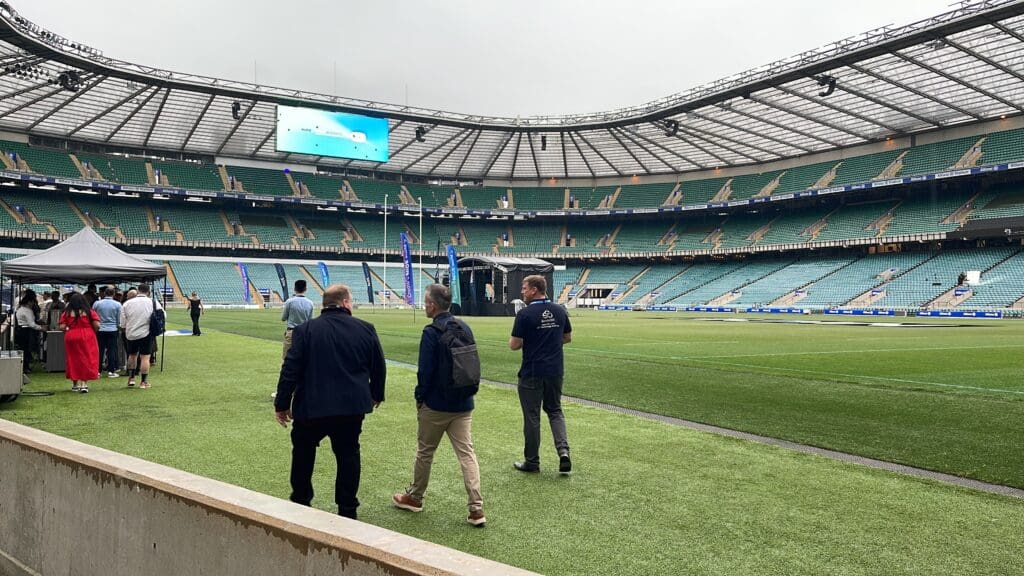NiCE Interactions International 2025 – AI is now a reality
The Cavell team joined NiCE (note the new styling) for their Interactions event in Twickenham, London earlier this week.
The event opened with CEO Scott Russell explaining the NiCE rebrand and the new tagline—creating a NiCE world.
NiCE’s new brand was on full display, with many signs and with a prominent position in Scott’s opening keynote. The new tagline was used heavily, and what that looks like depends on the speaker. If you ask Johnny Wilkinson, who came on that afternoon, it’s probably a world where England wins the next World Cup, but if you ask Scott Russell, it’s a world where CX adapts and proactively addresses customer service challenges.
To explain what this meant to NiCE, Scott also posed some challenging questions:
- What if the service found customers before they asked?
- What if proactive resolutions happened ahead of issues?
- What if each interaction unlocked new opportunities?
The overall theme of the show was intelligent automation, with a big focus on the new Mpower platform, which comes with a foundational layer of AI and then AI permeating throughout. Now, as I don’t believe in just throwing out the AI term and offering no explanation, let’s break this down further.
When NiCE talks about foundational AI in its product, it is talking about a data and knowledge management system that makes data accessible across the entire ecosystem. It’s an AI layer to feed other AI layers.
This is an area of competitive differentiation that NiCE’s competitors will also be looking to address as soon as possible. NiCE is making significant strides to build orchestration and integrate knowledge management as a central AI service, which differentiates it from many competitors who have not yet reached that stage.
We have finally reached ‘exponential’
One of the ideas that immediately caught my imagination came from Barry Cooper, the President of the CX Division at NiCE, who discussed ‘exponential consumers’ and ‘exponential businesses’. As an analyst, the incorrect use of the word exponential regularly gets my goat, but I feel it is accurate in this instance. If you were to chart a graph of consumer expectations of businesses and business expectations of themselves over time, it would be aiming directly for the ceiling, since ChatGPT first launched.
Essentially, we have a storm over the good ship CX, where consumers are constantly exposed to free, rapidly changing technology delivered to their pockets. ChatGPT, Gemini and Claude can be plied with a juicy prompt hanging from a bone to do any trick their new master desires which contrasts heavily with the clanging, clanking, and occasional sparking from legacy bots still wheezing through scripted decision trees and rule-based NLP – costing customer goodwill (and sanity) every time they miss the mark.
Customers are constantly experiencing the future’s exponential evolution, while CX remains stuck 2-3 years in the past, waiting for an upgrade cycle.
So, while customers are growing exponentially now, businesses at least need aspirations of being exponential; otherwise, they had better become exponential quickly if they want their customers not to leave for the competition that does.
Businesses are thrown the ‘exponential gauntlet’, charged with consumer expectations, a need to stay competitive and drive efficiencies, and a desire to build better, faster, and cheaper than ever.
I left this event thinking that NiCE had gotten its AI roadmap under control and was beginning to demonstrate some of the maturity the market needs if AI in CX is to deliver the returns the industry expects from it. But not all parts of the industry are at that stage, and the CCaaS channel has a long way to go to be as ready to sell AI as vendors like NiCE are, and customers might also need more time. However, if NiCE can continue to roll out customers with strong vertical use cases and demonstrate clarity on ROI, they should be on course for success.
WFM chats and how ‘Digital First’ shapes CX
For the afternoon, I joined the WFM stream, as I think it will play a much bigger role in Cavell’s CX practice in the future. Plus, it is one area that reinforces a refrain that anyone attending a Cavell event will have heard for the last year, ‘all this technology is great, but I’m not sure the industry’s processes have adapted to where they need to be.’
The first panellists – Adam Paginton from DHU and Carrie Ramskill from HGS – emphasised this for me. They were partly discussing advanced technology, but at the core of their discussion was changing the entire approach to managing contact centre workers.
In the old model, managers were militant and any employee wanting to take a sick day had to call and fill out a triplicate form before collapsing back into bed. Shifts had to be traded manually and signed off by management.
The new model can be encapsulated with ‘there’s an app for that’. Rather than enforcing strict processes, the company set up an app and login portal to enable employees to actively manage their shifts, report absences, and book leave.
However, there is also a layer of intelligence at play here. The company draws on new data enabled by the NiCE ecosystem to predict agent demand, peaks, and troughs and to manage resources across multiple high-volume critical lines. When an agent requests a half-day at short notice, wants a morning off, or calls in sick, the manager can easily see the impact on the contact centre and either approve or deny it.
Unsurprisingly, the absence rate dropped from 7% to 1% when this system was deployed. It turns out that when people can’t book time off, they pretend to be sick. If they get approved for sick leave, they figure it took so long they might as well make the most of it and take an extra few days to show how ill they were.
The other part of that talk, which I found fascinating, specifically focused on the type of work these people did. These were 111 emergency lines and could have some gruelling calls, resulting in an agent attrition rate of 20-40% depending on the year. This is the sort of high-risk, high-value environment that sentiment tracking for calls, employee stress tracking and all these other new metrics and evaluation tools that companies have been building feel like they were made for.
How do you stop an employee who has had a terrible series of calls from deciding that this isn’t the contact centre for them? Do you have a system in place that can identify when someone needs a break, such as giving them a day off or offering some other form of assistance? Or do you wait for them to snap and wonder where they went one day?

The impact of digital on customer service operations
Another interesting customer snippet I wanted to share came from Paul Bradley, Head of Transformation and Performance Enablement at Allied Irish Bank (AIB), who oversees a contact centre with over 700 agents that handles 4 million calls a month and deals with inquiries over phone, chat, social media and via digital agent escalations.
They are engaged in a similar journey to what was discussed all weekend, using AI to improve scheduling, deploying call summarisation, agent assistance, and improving their forecasts.
However, two interesting things stood out to me from Paul’s talk.
- AIB has successfully driven digital engagement with its website or app. He said the bank had around 3.5 million customers, and around 2.9 million engaged with the company via digital channels. But rather than drastically reducing headcount, it had just changed the sorts of queries they were facing, with roughly 40% of all inquiries now being ‘how do I get the app to work’. Paul highlighted that he had to pivot his contact centre scheduling to account for new Apple and Samsung launch dates and holidays like Christmas, when many people receive new phones. If you had told me a few years ago why a bank contact centre was busy in January, I would have said people were asking for overdrafts, not because they can’t get the app working on their new phone.
- Another great takeaway is that when it comes to building new bots, AIB thinks they already have the best employees for the job—the very agents the bots are (somewhat) displacing. Paul talked about the large efforts being made internally to upskill agents to become bot builders because he said that a lot of the frustrations that customers might have just don’t get put into workflows when a frontline agent is the one writing them. They automatically make the experience customer-focused.
Other thoughts
To wrap up, I think it was a great event. The strong message that AI is actually and is being put to work came across really well, in a way that it hasn’t at every event that I’ve been to in the last year. This was likely aided by the huge customer presence, not just AIB but also TalkTalk, Lloyds, and Carnival, to name a few big names.
This practical tone is exactly what Cavell advocates for in the market: move past blue-sky AI promises and focus on deliverables that shift real CX metrics. The industry needs clarity, and NiCE delivered more than most. From the early keynotes, where they discussed the real features of Mpower that are now live, to the discussion about building better RoI transparency, and then customers talking about how they are leading innovation and seeing results.
Oh, and listening to the Kaiser Chiefs on the main pitch at Twickenham helped too…
Cavell has recently published its annual CCaaS Market Evolution Report for 2025. In this report, we cover the findings from over 50 one-to-one interviews with most of the leading vendors and service providers worldwide to crystallise what is happening in the global CCaaS market.
The report also includes 24 individual country datasets, which show agent numbers, market size, and the impact of AI on headcount.
Get in touch for more information – Finbarr.begley@cavell.com
